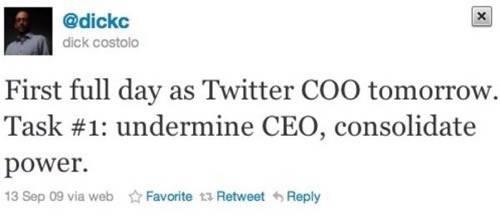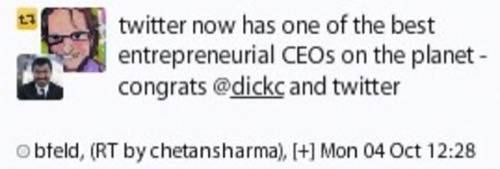
World-changer Evan Williams has stepped down as the CEO of micromessaging social network Twitter, the company announced today, and will pass that role to serial entrepreneur and company COO Dick Costolo. (Above, photo by Joi Ito)
Williams seems to spawn revolutionary publishing platforms with the wave of a hand: Blogger.com, Twitter and, though it didn’t work out as well, the podcasting platform Odeo. Costolo is best known to date for his work at Feedburner, the RSS publishing and analytics service bought and squandered by Google. RSS has been widely derided as too hard for consumers and relegated to obscurity “under the hood” – replaced even in the lives of many tech-watchers by Twitter. Costolo is uniquely fortunate to get to steer both of those ships in his career. If his past performance is any indication, his promotion should be very good for Twitter.
“I generally believe that for many technology companies, you need not necessarily have any idea how you will make money when you get started, and if you show good progress on the product and customer adoption, you need not make any commitments to a business model for some time… When asked about Google’s lack of a clear business model when he backed the company, John Doerr is said to have responded ‘With this kind of traffic, we’ll figure it out’. -Dick Costolo, January 2008
Before There Was Twitter
Trained as a computer scientist at University of Michigan, Costolo worked at the big management consulting firm Accenture for seven years. There’s a big gap in his LinkedIn profile between that period and his founding RSS feed service Feedburner. Anil Dash has written a very interesting account of the technologies and ad networks that key Twitter executives helped build years ago, arguing that the best way to understand where Twitter is likely to go in the future is to understand the pasts of the people running it. During that time, Costolo ran a company called SpyOnIt, basically a website scraping and change notification service that was sold to another company in time. The SpyOnIt team later built Feedburner.
Feedburner was a fascinating service, which still continues operating today. Publishers, from the smallest blogger to the biggest media companies, would point their RSS feeds at Feedburner, then get a new URL to offer to readers. The product delivered easy subscription, analytics, email delivery, feed augmentation with programmable meta-data (called Feed Flare) and inline advertising.

The advertising in Feedburner never seemed to work out terribly well, but the potential for it and the incredible customer base Feedburner built lead to Google’s acquiring the company in 2007. Google has since neglected the service terribly, reducing it to little more than an under-appreciated part of Google’s ad network. I have to stop writing now about the crime that is the general neglect of RSS, for fear that I will lose my temper over the world’s apparent preference for celebrity navel gazing in 140-character bites or the crude grunt of the Facebook “Like” to subscribe.
Turning Tweets Into Cash
So now Costolo runs Twitter. It was in September, 2009 that he came on board as COO. The company had listened to years of derision about its supposed lack of a business model while it was piling up loyal users at a pace envied by everyone but Facebook.
In the last entry posted to his personal blog almost three years ago, Costolo wrote:
I generally believe that for many technology companies, you need not necessarily have any idea how you will make money when you get started, and if you show good progress on the product and customer adoption, you need not make any commitments to a business model for some time. You do need to intimately understand where you sit in the proverbial value chain and what your position there means for your company, but you don’t need to know precisely how you will extract value. In fact, I’ll go farther and say that focusing on business model too early can hurt a company’s prospects. When asked about Google’s lack of a clear business model when he backed the company, John Doerr is said to have responded “With this kind of traffic, we’ll figure it out”.
Google, of course, now earns half as much revenue each year as is spent on advertising across all of television.
Twitter has shown signs of fast success with innovative advertising programs as well, thanks in large part to Costolo.
Evan Williams told TechCrunch today in an interview about the new roles for himself and Costolo: “I’m all about vision, he’s all about execution.”
Costolo is hardly short of vision, though. His leadership in creating advertising products for Twitter has been remarkable.
Promoted trends, the offering that allows brands to pay to push an already widely-discussed keyword to the trending topics list, is downright brave. It puts an advertiser’s message at the top of a search results page followed by a completely uncontrolled, uncensored flow of real-time Twitter messages about the brand being advertised. And companies pay for that! Early indications imply that they pay a lot and that they get a lot out of it. These are so much more effective and less obnoxious than standard display or keyword advertising! It’s unclear how well it will scale, though.
Promoted user accounts is the latest Twitter advertising scheme, and it looks quite good as well. Advertisers buy promotion as a person-to-follow for users who have expressed interest in the type of content those advertisers are publishing – like basketball or movie stars. Then users opt-in to subscribing to updates pushed from the advertiser into the indefinite future (great for advertisers) – with the understanding that if the advertiser doesn’t continue to add value, they will be unsubscribed from (that’s great for users). The new “who to follow” algorithm for personalized recommendations, and offering targeted promotional recommendations there, is a much better idea than Twitter’s original Suggested Users List, which was offensive and the company didn’t even make any money off of.
Promoted trends is downright brave. It puts an advertiser’s message at the top of a search results page followed by a completely uncontrolled, uncensored flow of real-time Twitter messages about the brand being advertised. And companies pay for that.
@earlybird, the company’s account that broadcast daily deals, didn’t seem to work out, but two out of three radically new advertising products isn’t bad. Even EarlyBird shipped and made sense; that’s more than can be said about the Business User accounts that Twitter has been working on without launching for years.
Now that Twitter’s user-base has exploded, now that it’s seized huge mindshare around the world, it’s time to put the man who lead the creation of the company’s monetization program in charge of the company. That makes sense.
What’s Costolo like to deal with? While Evan Williams is generally aloof, Costolo is one of the most personable executives in the industry. “He’s the most incredibly responsive CEO I’ve ever come across in my life,” says ReadWriteWeb founding editor Richard MacManus about his interactions with Costolo as an early blogger using Feedburner. “He’s really into it from a customer relations point of view, which is probably going to help Twitter a lot.”
Above: Tech luminaries like investor Brad Feld and wireless industry analyst Chetan Sharma line up to publicly congratulate the well-liked Costolo, on Twitter of course.

If you believe that Twitter is of net-benefit for the world, and only someone who hasn’t used it much would say otherwise, then what’s good for Twitter is good for the rest of us, too. Costolo’s adventures with the last world-changing messaging system he lead may have worked out better for himself than for the rest of us in the long run, but his work at Twitter so far has been key at building staying power for this new, more accessible way for people around the world to speak with each other.










